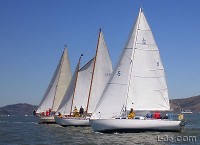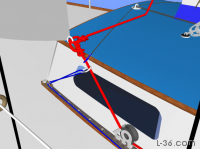Racing
How to Point Higher
By Allen Edwards
Introduction

I have been racing at SPYC for 10 years and that represents almost all my racing experience. I am thankful to the club for this experience and it has helped me a great deal to become a better racer. I am also grateful to other skippers who are far better racers than I will ever be for sharing many insights and tips on sailing. While I do not consider myself an expert racer, I would like to continue the tradition of sharing what I have learned in hopes of making other boats faster as well. In my case, there are two things that help Papoose win races. One is having lots of wind when racing against much lighter boats. The other is pointing ability. It is my hope that this article might help other people discover new pointing ability in their boats.
How to point higher:
The points below cover some of the factors we have found are important. For more reading, there are many articles by people more expert than I posted on http://L-36.com/racing.php. I encourage you to explore them.Mainsail Trim:
For pointing the leech should be tight. In the high winds like we usually have at Sierra Point you need to let the main out to control heel and that means you need to lower the traveler. What we do on Papoose is to keep the traveler low and let the sail out to put a bubble in the luff of the main if we need to get rid of power. This is very difficult and requires the mainsheet trimmer to constantly play with the sheet. You need a strong, physically fit mainsheet trimmer. The mainsheet is almost never cleated off during a race and never in heavy air close-hauled. In very heavy winds or if you cannot bubble the main, bring the traveler up and twist off the main so that wind is spilled off the top. In light air, the traveler comes up as the boom comes up to the boat centerline. In medium winds, play the traveler as the wind changes. It is always better to use the traveler as the adjustment so that the twist of the main stays constant but eventually you run out of traveler motion. That said, because the length of our traveler is short and end boom, we have started using the vang to control leech tension so we can just use the mainsheet to play the wind. This is very boat dependent and beyond the scope of this article.Headsail:
To point well in the high winds we have you really need a #3 jib (about 90%). We have used nothing this season other than our 90% jib (upwind and downwind I might add). The worst thing for pointing is a #2 or 130 jib because it is going to be constrained by the rigging and sheeting to the widest part of the boat. A furling jib part way out cannot point as well, although sail makers try and tell you they have a special way to make that happen. It is just not going to point as well as a task specific sail. The next best pointing sail would be a 155 as it sheets back toward the stern and thus has a narrow sheeting angle but that is for lighter days than we have had. On Papoose we have a 90, 130, and 155. We never use the 130. If I were to answer the question what is the one jib I should buy for sailing or racing where we sail it would be a #3. If you are looking for a used sail, I have a page that will search many national vendors for sails that fit your specific boat http://L-36.com/find_used_sails.phpTrack location:

We added an inboard track on Papoose near the cabin. We also have an inhauler rigged. If you don't have an inside track, you might consider adding an inhauler. There are a couple of articles on L-36.com on inhaulers. Here is the main one http://L-36.com/inhauler.php Our track is inboard enough that we don't need the inhauler for sheeting angle. We use it in rough seas where we want a fuller jib shape for power but we want to keep the tight sheeting angle. We get that by letting the sheet out a few inches and bringing the clew back inboard with the inhauler.
I should mention that the goal is to have to boat go higher, not just to have the bow pointing higher into the wind. You theoretically can make the sheeting angle so tight that the boat will point very high but just start to slip sideways so there is an optimum and it is not the case that tighter is always better.
Forestay:
A tight forestay means better pointing. To get 1,200 pounds on Papoose, which is all I'm comfortable with putting on my old wood mast, we take in 1.4 inches on the backstay before every race and release it after the race. For comparison, a sister ship, but with an aluminum mast and size up wire, puts about 4,000 pounds on his forestay and takes over 6 inches out of his backstay to do it. He consistently out points me. I am not suggesting you break your boat but just realize that forestay tension is very important to pointing ability and find out how boats like yours are tuned. There are tuning guides on the web for many production boats. Halyard tension: Halyard tension is an adjustment. More halyard tension moves the point of maximum curvature forward. You want that point in the forward part of the sail. More wind means more halyard tension. We sometimes luff up going upwind to add more tension.Jib trim:
For high winds, the jib foot needs to be flat. Halyard tension and forestay tension are important but so is the jib car position. There are articles that cover this but typically we have the jib foot with just the slightest curvature, almost flat. If it is an overlapping sail, the foot is against the rigging and the sail is just an inch or two off the spreader. In general, you want the twist of the jib set so that all the telltails break at the same time but in very high winds you should bring the jib car back and let the jib twist off to spill some power.Driving the boat:
The helmsman needs to sail looking at the jib all the time. It takes a lot of concentration. In light winds the telltails should flow back parallel to each other. In heavy winds the windward telltails should not flow straight back but flutter up. We made several changes on Papoose to allow for better steering. We got a tiller extension so I could see the lower telltail. We also installed some foot rests so I could sit high enough to see as Papoose occasionally heals 45 degrees and I don't want to fall. I said the lower telltail because my job in steering the boat is to keep the boat sailing at the best angle to the wind. It is the job of the trimmers to keep the sail shape right thus their job is the relationship of the telltails and mine can be accomplished with the one easiest to see. Doing this takes practice as there is a very small difference between sailing high and getting an accidental tack. Don't ask me how I know.Target Boat Speed:

Some people say that the secret to sailing higher is to push the tiller away from you. This is the case when a boat is sailing faster than its target boat speed. For any given wind speed, there is a target boat speed where you are making the best time to windward. Sailing too high drops that speed and sailing too fast means you are not pointing high enough. If you get to know your target boat speed, it is the most accurate and sensitive indicator of whether you are sailing high enough. Papoose's Target Boat Speed upwind is 6.5 knots in high wind. If I am going faster, I sail higher and slow down. If I am sailing slower, I foot off and get my speed back up. Again, I wrote way too much on this topic on L-36.com if you are interested.
Physical Condition:
I want to close on something not mentioned much in sailing articles. Sailing is a physical demanding sport as my aching body here on Thursday after a demanding Tuesday race is evidence. Grinders need strength and endurance. Mainsheet trimming is a constant battle against each change in wind. Holding the best course, going up on each puff, takes a lot out of a person. If you are going to go fast, you need to be fit. I hope you found these tips interesting. All were handed down to me and I am just handing them down to you. They are not my ideas but they have worked well for us.NOTICE: Some pages have affiliate links to Amazon. As an Amazon Associate, I earn from qualifying purchases. Please read website Cookie, Privacy, and Disclamers by clicking HERE. To contact me click HERE. For my YouTube page click HERE